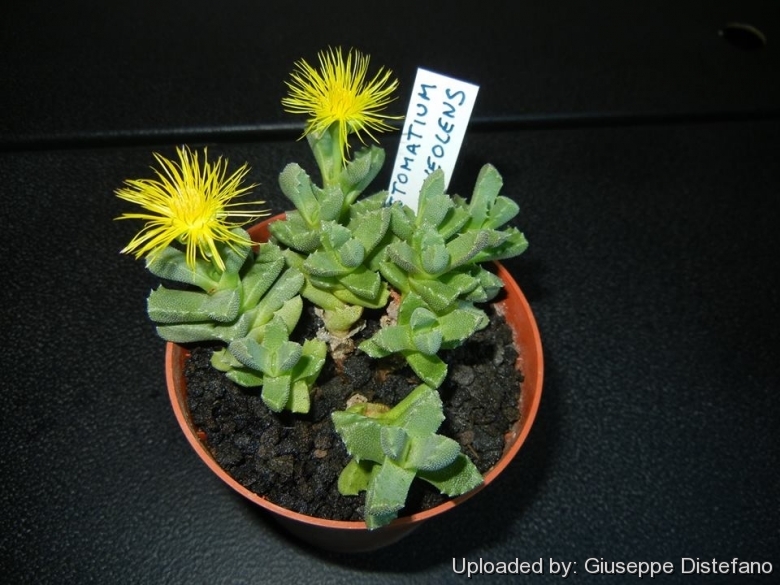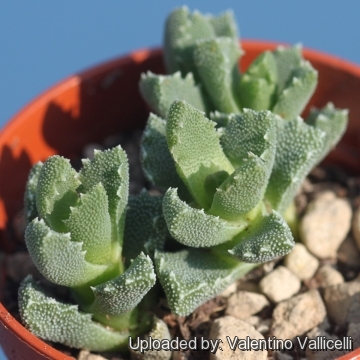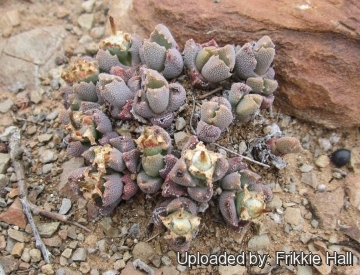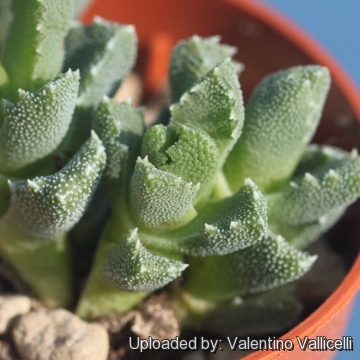




Your support is critical to our success.

Origin and Habitat: Fraserburg, Sutherland, Williston, Northern Cape Province, South Africa.
Habitat: It grows in shallow pans and along their edges.
Synonyms:
- Stomatium suaveolens (Schwantes) Schwantes
- Mesembryanthemum suaveolens Schwantes non Jacq.
Description: Stomatium suaveolensSN|27224]]SN|27224]] is a dwarf, compact, succulent plant forming clumps that are flat to semi-globose in habitat. It is one of the Stomatium, with toothed leaves like open mouths.
Stem: The young plants are stemless, but they have short stems when old.
Leaves: 4 to 6 on a growth, 10-20 mm long, 9-15 mm broad, 7-9 mm thick, pale green, very fleshy, erect or spreading, spatulate with a thick, prominent chin at the apex, the leaf tips almost semi-lunate as seen from above, the backs very rounded and distinctly keeled towards the tip, the keel more evident in cultivation than in habitat, the edges and keel have either no teeth or one to five small, hardly visible teeth. Leaf-surface with numerous elevations and pale dots giving the leaf a rough appearance, epidermis with a thick layer of crystal sand, stomata only very little sunken.
Flower: Yellow with a delicious night perfume, tube 5 mm long, petals yellow, anthers yellowish.
Blooming season: The flowers are freely
Fruit: Base bowl-shaped, breaking off the stalk when ripe, ochre with red dots, top rising a little to the centre, septa with extremely narrow rims, rising to the centre, valve wings as broad as the expanding keels, narrowing to their bases, 5-5.3 mm in diameter.
Seeds: 0.75-0.85 mm long, 0.6-0.72 mm wide.
Bibliography: Major references and futher lectures
1) Heidrun E. K. Hartmann “Aizoaceae F – Z” Springer, 2002
2) Jacobsen. “Handbook of succulent plants” 1328 (1960)
3) James Cullen, Sabina G. Knees, H. Suzanne Cubey “The European Garden Flora Flowering Plants: A Manual for the Identification of Plants Cultivated in Europe, Both Out-of-Doors and Under Glass - Casuarinaceae to Aristolochiaceae” Cambridge University Press, 11/ago/2011
4) Riha & Subik “The illustrated encyclopaedia of cacti and other succulents” 1981
5) E. K. Hartmann “The Illustrated Handbook of Succulent Plants” 2001
6) S. H. Scott “The Observer's Book of Cacti and Other Succulents” F. Warne, 1958
7) Margaret J. Martin, Peter Richard Chapman “Succulents and their cultivation” Scribner, 1978
8) Nicky Hayden “Cacti, succulents & tropical plants” Marshall Cavendish Publications Ltd., 1975

Stomatium suaveolens Photo by: Valentino Vallicelli

In habitat along the R388 between De Aar and Richmond. Photo by: Frikkie Hall

Stomatium suaveolens Photo by: Valentino Vallicelli
The gallery now contains thousands of pictures, however it is possible to do even more. We are, of course, seeking photos of species not yet shown in the gallery but not only that, we are also looking for better pictures than those already present. Read More...
Cultivation and Propagation: Stomatium suaveolensSN|27224]]SN|27224]] is a "summer grower" which is most active from early spring and heading for winter dormancy, but in favourable growing conditions it keeps going over the winter too and doesn't need particular care. Stomatium suaveolensSN|27224]]SN|27224]] seems to prefer a fairly dry rest in winter but flowers profusely whenever watered. It is the good choice for anyone wanting to start growing succulents. It is quite hardy and can take a light frost and in very dry warm-temperate regions these succulents make very impressive out door ground covers.
Growing rate: It is vigorous and quick-growing, speedily forming lateral shoots and low mats.
Soil: Requires good drainage as it it is prone to root rot. It can grows outdoor in sunny, dry, rock crevices (protection against winter wet is required) It can also be cultivated in alpine house, in poor, drained soil.
Fertilization: Feed it once during the growing season with a fertilizer specifically formulated for cactus succulents (poor in nitrogen), including all micro nutrients and trace elements diluted to ½ the strength recommended on the label. It thrives in poor soils and need a limited supplies of fertilizer to avoid the plants developing excess vegetation, which is easily attacked by fungal diseases.
Watering: They are not at all delicate and can take some water year-round. Water minimally in winter, only when the plant starts shrivelling, water more abundantly when they are growing in the spring and summer, but let the soil dry between soaking. An occasional summer soaking is wise. If grown in a container, bottom watering by immersing the container is recommended. It must have very dry atmosphere.
Light: It needs a bright sunny or light shade exposure in winter, but keep cool and partially shaded in summer.
Hardiness: It prefer a very bright situation and require a minimum temperature 0°C (But will take frost and is hardy down to -20° C or less for short periods if it is in dry soil ). USDA zones 8 – 11. The earlier in the year they are planted, the better the chances for winter survival. True with many of the Mesembryanthemaceae.
Uses: They are hardy and they look fine in a cold greenhouse, frame, in containers or outdoor in a rockery.
Pests & diseases: Stomatium suaveolensSN|27224]]SN|27224]] may be attractive to a variety of insects, but plants in good condition should be nearly pest-free, particularly if they are grown in a mineral potting-mix, with good exposure and ventilation. Nonetheless, there are several pests to watch for:
- Red spiders: they may be effectively rubbed up by misting the vulnerable plants every day
- Mealy bugs: Occasionally they develop aerial into the new leaves and flowers with disfiguring results, but the worst types develop underground on the roots and are invisible except by their effects.
- Sciara Flies: they are one of the major problems for seedlings. It is a good practice to mulch your seedlings with a layer of grit, which will strongly discourage the flies.
- Scales, thrips and aphids: they are rarely a problem.
It is wise to treat your whole collection with a systemic insecticide twice a year in spring and autumn.
- Rot: it is only a minor problem with mesembs if the plants are watered and “aired” correctly. If they are not, fungicides won't help all that much.
Propagation: It is very quick and easy to start from seed or cuttings. Seeds germinate in 7-14 days at 21°C in spring. To make a cutting twist off a branch with at least a part of roots and permit it to dry out a couple of days, lay it on the soil and insert the stem end partially into the soil. Try to keep the cutting somewhat upright so that the roots are able to grow downward. Stomatium will hybridize with Titanopsis (day meets night) and Neohenricia.
| Your Actions | |
|---|---|
| Back to Stomatium index | |
| Back to Aizoaceae index | |
 |
Back to Succulents Encyclopedia index |
Privacy stantement - Terms and conditions - How to cite - About us - Feedback - Donate



